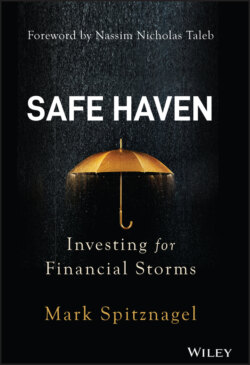Читать книгу Safe Haven - Mark Spitznagel - Страница 9
PROBING BETS
ОглавлениеThis book is the result of a discovery process and problem‐solving effort that began many years ago. I grew up a scrappy, poor kid in the Chicago commodities trading pits, back when they were the center of the financial universe. As a mere teenager, I learned from my mentor, Everett Klipp (“the Babe Ruth of the Chicago Board of Trade”), who told me over and over that “a small loss is a good loss,” and that risk mitigation and survival are everything in trading and investing. His words still ring true today: Take care of the losses; the profits will then take care of themselves. Profits matter only relative to the losses; stay in the game by protecting your capital base, your means of playing the game. Don't predict.
Pretty obvious stuff, except people don't really focus on losses, especially the potential for big ones. In all my experience, most investors don't think about the impact of the downside the way they need to; they just don't.
For me, it began with hands‐on, trial‐and‐error experiments in my twenties as a “local” (or independent) trader in the bond pit in Chicago. (I earned much of my stake in college by writing and then selling the first portfolio management handheld computer program on the trading floor.) It continued in my thirties as a bank proprietary and hedge fund derivatives trader in New York, and even a bit in the hallowed halls of New York University's Courant Institute of Mathematical Sciences. I hashed it out in endless discussion‐walks through the streets of Manhattan with Nassim Nicholas Taleb, in the days when we started the very first formal tail hedging program, and he would later become Scientific Advisor at Universa. These ideas were the point of every conversation during countless, reckless longboard skateboard cruises up and down the treacherous hills and dales of Central Park with Brandon Yarckin as we plotted the launch of Universa, where he would become COO. (I still blame Brandon for my separated shoulder.)
And it goes without saying that I have not made these observations from scratch. I owe an enormous gratitude to the explorers who plumbed the depths (“the triad”).
These were the formative years of probing bets, of bold conjectures and refutations, and finding answers to how things worked through success and failure—of a bloody war against luck. The conclusion was my decision to start Universa in 2007, where we have taken our discoveries and solutions and transformed them into a formal, rational, and practical investment approach that solves the big problems and moves the needle for my investment partners.
By opening this book and, I would hope, opening your mind to the ideas it contains, you will have the opportunity to change your perceptions about investing and risk mitigation. These pages will present a fundamentally different, unconventional perspective that I firmly believe is the most effective one for successful investing. It opposes so much of what is hailed as gospel within the collective that is the investment profession. So, we need to think objectively about the orthodoxy and dead‐end dogma of modern finance. We need to be the uncarved block.
To be sure, I have no interest in changing the existing investing paradigm by making it obsolete. I'm no pied piper, and I harbor no delusions of grandeur that the message of this book will ever become “the new gospel according to Mark.” I do not expect for one moment that my approach will ever become another cookie‐cutter, rubber‐stamped strategy of the investment consultant herd. And that's important. Becoming conventional is self‐defeating in this business. It's the kiss of death. We take the road less traveled by, and that has made all the difference.
I have often exclaimed to my team at Universa, plundering the words of Steve Jobs, “We are pirates! Not the Navy!” (Mine are the smartest, savviest, and most experienced Great Pirates in the derivatives world.)
